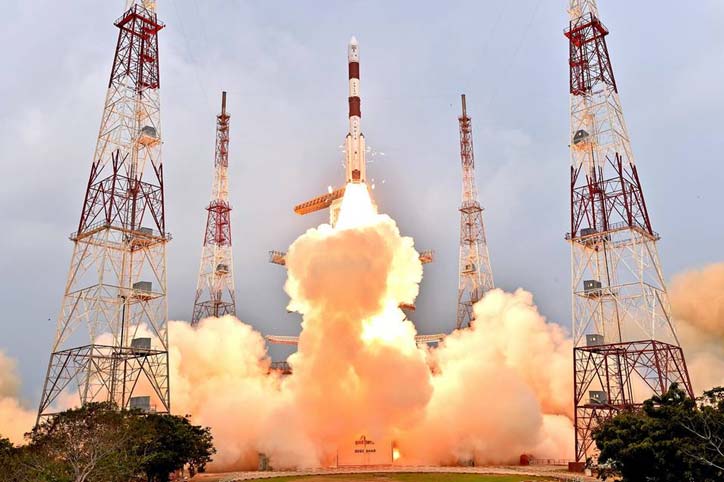 Bengalure:
Bengalure: After years of preparation, the Indian Space Research Organisation (ISRO) just weeks ago decided to change the Chandrayaan-2 mission, which will now see the Lander — that was initially going to soft land directly and unload the Rover — to actually go around the Moon in an elliptical orbit before descending on the dusty terrain for a battery of tests.
This mission, unlike Chandrayaan-1 which only orbited the Moon, involves a Lander soft-landing on the lunar surface and unloading a Rover to study and take measurements from the Moon, while the orbiter will go around the Earth’s satellite. Initially, the project was to be a joint mission with Russia, whose space agency Roscomos was to supply the lander. However, that deal fell through and Isro decided to go solo.
The decision on how many orbits the Lander will make has not yet been taken, but it will be a 100x30 (100km on one side and 30 on the other) elliptical orbit, which means that the entire configuration of the mission has now changed, in effect, causing the delay.
“Earlier, the plan was to gradually go down from 100km and reach 18km from the Moon’s surface. From there, the orientation would change, making the Lander go slightly horizontal for about 8.5km and then we were to change the orientation and velocity further to make the soft landing,” a senior member of the Chandrayaan-2 team said.
Now, as per the revised plans, the Lander has to go around the surface of the moon before entering the descent phase. Scientists working on the project say that this change in plan could have been avoided as the earlier configuration that was cleared would have achieved the main mission goals.
“This additional activity required by the Lander means a host of new hardware added. This is one method of achieving the landing, while the earlier one was another. Our job is to follow what the chairman and other seniors decide and develop things that can successfully complete the mission,” another scientist said.
This has also increased Chandrayaan-2 weight from 3,250kg to 3,850kg, which has prompted some changes, including moving to GSLV MK-III instead of the GSLV MK-II, which would have required an uprate to accommodate the additional weight.
New configuration & soft landing issueAs per the new configuration cleared after the fourth Comprehensive Technical Review (CTR) meeting held on June 19, among other things, the Lander would require a fifth liquid engine to manage the additional load of having to orbit, along with other hardware including a transponder which it earlier didn’t need.
“All these last-minute changes means that we have to test all the new hardware and then begin the fabrication process, which will delay the project. Also, the software algorithms need to change as the mission profile itself has been altered, and even this would need tests,” the scientist said.
“The fifth Centrally mounted 800N Steady State Liquid Engine with additional hardware has been included to mitigate upward draft of dust to craft while landing,” the Isro has found.
Also, the Lander will have a new Lander Leg configuration with increased base diameter (from 3.6m to 4.34m) which is to improve the stability margins.
Why the orbitingAccording to the committee, the Lander is now required to orbit so that it can make “assessment of various system performances before the actual critical Powered,” and to do this, the descent phase requires the inclusion of four reaction wheel and its drive electronics as well as two micro Star Sensors (main & redundant) which will enable it to measure the moving velocity and help land.
It will also have transponders for ranging and doppler functions with the antenna configuration and a host of additional supporting systems—power, structure, thermal, etc, will also be added.
Besides, there will be two additional propellant tanks (390L capacity), additional pressurant tank (35.5L capacity) among other changes.
ISRO chairman K Sivan did not respond to repeated calls or messages, while M Annadurai, who was leading the project from its inception until July 31, said: “I am out of the system and it will be inappropriate to comment on an ongoing project.” # Source: TOI, By Chethan Kumar
 Bengalure: After years of preparation, the Indian Space Research Organisation (ISRO) just weeks ago decided to change the Chandrayaan-2 mission, which will now see the Lander — that was initially going to soft land directly and unload the Rover — to actually go around the Moon in an elliptical orbit before descending on the dusty terrain for a battery of tests.
Bengalure: After years of preparation, the Indian Space Research Organisation (ISRO) just weeks ago decided to change the Chandrayaan-2 mission, which will now see the Lander — that was initially going to soft land directly and unload the Rover — to actually go around the Moon in an elliptical orbit before descending on the dusty terrain for a battery of tests.